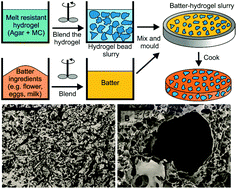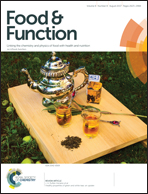Structuring and calorie control of bakery products by templating batter with ultra melt-resistant food-grade hydrogel beads
Abstract
We report the use of a temperature insensitive, food-grade hydrogel to reduce the caloric density of pancakes that were prepared at temperatures much higher than the boiling point of water. This cheap, facile method utilises a mixed agar-methylcellulose hydrogel, which was blended to produce a slurry of hydrogel microbeads. The pancake batter was mixed with a controlled volume percentage of slurry of hydrogel beads and cooked. From bomb calorimetry experiments, the composites were found to have a reduced caloric density that reflects the volume percentage of hydrogel beads mixed with the batter. Using this procedure, we were able to reduce the caloric density of pancakes by up to 23 ± 3% when the volume percentage of hydrogel beads initially used was 25%. The method is not limited to pancakes and could potentially be applied to various other food products. The structure and morphology of the freeze-dried pancakes and pancake-hydrogel composites were investigated and pores of a similar size to the hydrogel beads were found, confirming that the gel beads maintained their structure during the cooking process. There is scope for further development of this method by the encapsulation of nutritionally beneficial or flavour enhancing ingredients within the hydrogel beads.



 Please wait while we load your content...
Please wait while we load your content...